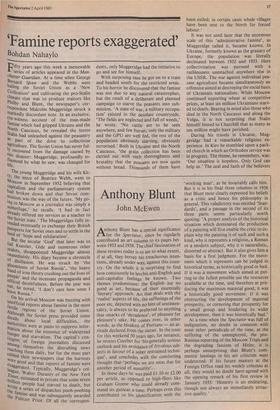Anthony Blunt
John McEwen
Anthony Blunt has a special significance for the Spectator, since he regularly contributed an art column to its pages bet- ween 1933 and 1938. The chief fascination of these reviews today is to see to what extent, if at all, they betray his treacherous inten- tions, already under way, against this coun- try. On the whole it is surprising to find how consistently he lets his anti-English and anti-capitalist feelings be known. Two themes predominate: the English are no good at art, because of their essentially 'literary' approach. Art that deals with the 'realist' aspects of life, the sufferings of the poor etc, depicted with no hint of sentimen- tality, is always to be preferred to anything that smacks of 'decadence', of pleasure for pleasure's sake. He comes over, in other words, as the bleakest of Puritans — an at- titude declared from the outset. In the issue for this weekend 50 years ago, for instance, he reveres Courbet for 'his generally serious outlook and his avoidance of frivolous sub- jects in favour of a sober restrained techni- que', and concludes with the comforting thought that , 'perhaps we are soon due for another period of austerity'.
In those days he was paid £1.10 or £2.00 per article, as opposed to high-fliers like Graham Greene who could already com- mand six guineas a time. Perhaps even this contributed to his identification with the 'working man', as he invariably calls him. But it is in his final three columns in 1938 that Blunt most clearly expressed his beliefs as a critic and hence his philosophy in general. This valedictory was-entitled 'Stan- dards', and a passage in the second of its three parts seems particularly worth quoting: 'A proper analysis of the historical situation which dominated the production of a painting will first enable the critic to ex- plain why the painting is of such and such a kind, why it represents a religious, a Roman or a modern subject, why it is naturalistic, distorted or abstract. But it also gives him a basis for a first judgment. For the move- ment which it represents can be judged in historical terms, as historically good or bad. If it was a movement which aimed at put- ting to the fullest possible use the resources available at the time, and therefore at pro- ducing the maximum material good, it was a historically good movement. If it was obstructing the development of material prosperity, or cornering that prosperity for a small group and hindering its wider development, then it was historically bad.'
At a time when the Spectator was full of indignation, no doubt in common with most other periodicals of the time, at the suffering of the unemployed, the pro- Russian reporting of the Moscow Trials and the degrading fascism of Hitler, it is perhaps unsurprising that Blunt's com- munist leanings in his art criticism went undetected. If his future masters at the Foreign Office read his weekly columns at all, they would no doubt have agreed with the opening remark of his first review in January 1933: 'Honesty is an endearing, though not always an immediately attrac- tive quality.'






































 Previous page
Previous page